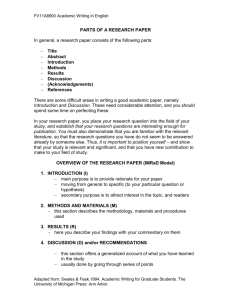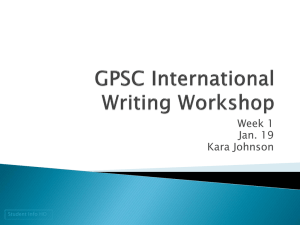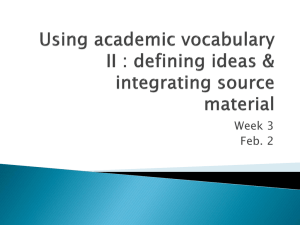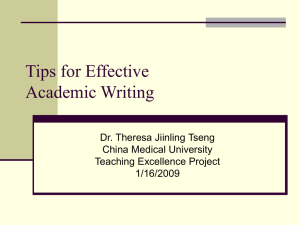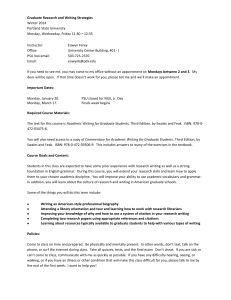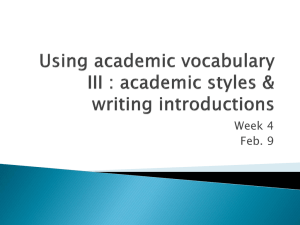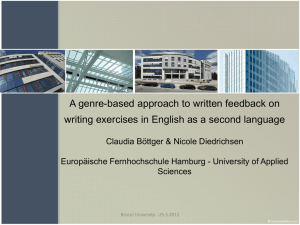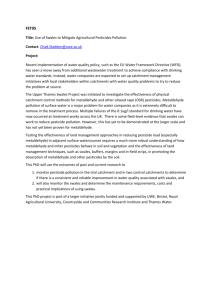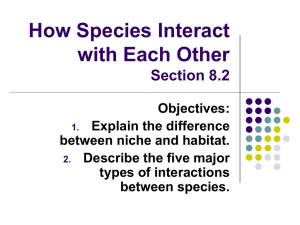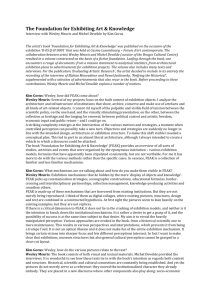Week 5: Using academic vocabulary IV
advertisement
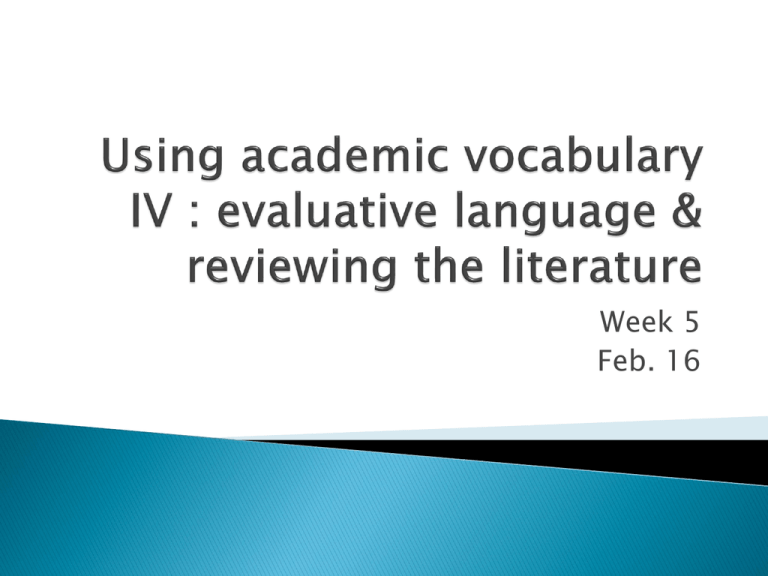
Week 5 Feb. 16 Reviewing the Literature Academic Vocabulary IV ◦ Evaluative Language Where in your writing do you cite sources? ◦ Introduction? Methods? Results? Discussion? ◦ All are possible, but it depends on the field and type of writing What are the purposes of citing? (besides plagiarism!) ◦ ◦ ◦ ◦ Acknowledge intellectual property rights Show respect for previous scholars Give your own arguments greater authority Help friends and colleagues (increases the “impact factor” of journals) (Swales & Feak, 2012, p 340) Tense choice implications are subtle ◦ Can indicate who is the agent or not ◦ Can make no reference to agency ◦ Can indicate the distance of the researcher to our own opinion or research ◦ Can indicate if the finding should be taken in the context of the single study or as a larger generalization. Look at a journal you brought and find examples of this. Now look at your own. P344-345 HO Huang (2007) investigated the causes of airport delays. ◦ ◦ ◦ ◦ ◦ Action (Huang does something) Developed Modeled Conducted studied ◦ ◦ ◦ ◦ ◦ ◦ ◦ ◦ ◦ Saying/thinking (Huang says/thinks something) Believes Assumes Posits Argues Opines Views Points Provides… In Huang’s (2007) investigations, he concludes that….. Past is often used to indicate a contrast of past belief to current: ◦ Huang (2007) concluded that…, but more recent investigations reveal… Integrated citations versus parenthetical citations: ◦ According to Suarez et al. (2010), the causes of business failure are closely related to the ratio of working capital, retained earnings, and sales. ◦ Fang’s research shows that reduced working capital and retained earnings are interrelated (Fang, 2007). Why was the first integrated, and the second not? What are other ways of giving credit? Under what circumstances are one or the other preferred? Why vary citation patterns? Give it a try ◦ The Origins of the First Scientific Articles Options for establishing a niche: Stronger ◦ A: Counter-claiming (something is wrong) ◦ B: Indicating a gap (something is missing) ◦ C: Raising a question or making an inference (something is unclear) ◦ D: Continuing a tradition (adding something) Weaker Look at a journal you brought and find an how the author(s) established their niche. Now look at your own. Was it the niche you intended? P348-349 HO (Swales & Feak, 2012, p 348) How to focus/synthesize/organize the previous finding? (pdf, p27-34 for example) ◦ By possible relationships between the chosen constructs (e.g., a correlation between communication and satisfaction and job satisfaction) ◦ By possible mediating (intervening) and/or moderating variables that influence the relationships between chosen constructs ◦ By possible differences between groups in chosen constructs ◦ By possible gaps, inconsistencies, controversies and/or unanswered questions which form the basis for a new study ◦ By possible untested hypotheses or propositions in the chosen constructs (Kotze, 2007, p 26) Practical principles that can accomplish good organization (pdf, p34-40 for examples): ◦ Use a “funnel approach” by starting with the broader context and then focus in on the specific topic and issue ◦ Carefully plan headings and subheadings that can ensure a logical flow of information (mind-maps can help in planning) ◦ Headings should be descriptive and informative (more than one word) ◦ Make sure that information under heading is in fact well related (Kotze, 2007, p 26) Practical principles that can accomplish clear style (pdf, p42-43 for examples): ◦ Write to the level of an intelligent layperson (i.e., non-academic, no expertise in the discipline of the field), such as a 100 level class in your field. ◦ Always define unfamiliar constructs or technical terms when they are introduced the first time. ◦ Write as though your reader is skeptical about what you write, and you need to argue your case with clear evidence and reasons for your choices. (Kotze, 2007, p 41) Evaluative Language, when we return Negative openings for indicating a gap: ◦ “little” + noun However, little information… Little attention… Little work… ◦ “few” + noun However, few studies… Few investigations… Few attempts… ◦ No/none No studies/data/calculations to date have… None of these studies/findings/calculations have… P350-51 HO (Swales & Feak, 2012, p 350) Contrastive statement openings for indicating a gap: ◦ Research has tended to focus on …, rather than on… ◦ These studies have emphasized …, as opposed to… ◦ Although considerable research has been devoted to…, rather less attention has been paid to… (Swales & Feak, 2012, p 352) Consider the first two paragraphs of an article from the Journal of Materials Chemistry (PDF) ◦ How many critique/evaluative expressions can you find? (write the expressions on your own paper) ◦ Are they strongly negative or slightly negative? ◦ Can you find the language that signaled Move 1 (Establish a Research Territory)? ◦ Can you find the language that signaled Move 2 (Establish a niche)? (Swales & Feak, 2012, p 354) Consider the introduction in a journal you brought: ◦ How many critique/evaluative expressions can you find? (write the expressions on your own paper) ◦ Are they strongly negative or slightly negative? ◦ Can you find the language that signaled Move 1 (Establish a Research Territory)? ◦ Can you find the language that signaled Move 2 (Establish a niche)? Now consider these same questions for your own introduction. (Swales & Feak, 2012, p 354) …remains elusive despite… There are however very few analyses…. Yet, the literature has little empirical evidence… …is far from sufficient… Very little research has been done to answer the crucial question… Has not been fully answered…. Evaluative language can be used in claims about your own writing and about others’ writing. ◦ Phrases can weaken and strengthen P160-161 HO ◦ Distance can weaken and strengthen ◦ Verbs can weaken and strengthen (appear, seem, tend) Do you prefer to look at models (journals you brought) or your own writing? ◦ Look for this language in the intro (establishing a niche), in data commentary (remarking about your data), discussion (making final claims) (Swales & Feak, 2012, p 160) …can be reasonably confident… …may be… …it would be useful to confirm… It is some concern that… Grammar & wording Literature review ◦ Goes too quickly to the study issue without situating it in the related research ◦ Insufficient review of the literature, causing the reviewer to note oversights & misunderstandings ◦ Personal definitions rather than giving attribution Analysis & design ◦ Claims about results were problematic for the research design ◦ Sample size too small for the complexity and claims ◦ Causes and effects in the design not well addressed Continue to apply what you’ve learned in your editing. Consider staying on contact with your peer from class or connect with someone else, both for encouragement and support. Feel free to see the powerpoints from this workshop at http://www.u.arizona.edu/~karaj/gpsc.html
